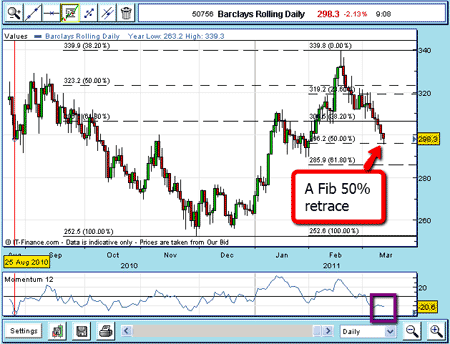Revisiting the Barclays share price – how to trade with Fibonacci
John Burford looks at using Elliott wave and Fibonacci principals in this short trade on Barclays shares.
Revisiting the Barclays share price how to trade with Fibonacci
In a recent post, I showed that Barclays shares were conforming very well to both Elliott wave and Fibonacci principles, which should allow low-risk trades to be put on.
In this brief follow-up, I will show how a short trade made at the February rally to 340p was closed out at a nice profit on Friday just past.
MoneyWeek
Subscribe to MoneyWeek today and get your first six magazine issues absolutely FREE

Sign up to Money Morning
Don't miss the latest investment and personal finances news, market analysis, plus money-saving tips with our free twice-daily newsletter
Don't miss the latest investment and personal finances news, market analysis, plus money-saving tips with our free twice-daily newsletter
Recall that the 340p level was reached in a spike to a significant Fibonacci retrace level where I put on a short trade using a 10p stop at 350p. This was within my 3% rule limits.
Because the rally to 340p from the November 252p low occurred in five waves (which were textbook in form complete with a negative divergence with momentum at wave 5) I was expecting a three-wave correction down.
As trading progressed down, I then lowered my stop to break-even, following my break-even rule.
As expected, momentum readings started falling from their high levels at 340p, and on Friday, the market hit the 296p level on oversold momentum (marked in purple box on the daily chart below). Incidentally, I use mostly daily charts for individual stocks, and mostly hourly charts for stock indexes and the other markets I trade.

(Click on the chart for a larger version)
I have drawn the Fibonacci retrace levels using as top pivot the 340p high, and the bottom pivot the 252p low.

Claim your FREE report: The 6-step game-plan for
spread betting profits
Right on cue, the market on Friday fell right to the Fibonacci 50% retrace at 296p, where I took profits for a very nice 42p gain in less than three weeks.
Now why did I take profits there? Recall I was looking for an A-B-C three-wave pattern down. Although not perfect in shape, I can make a case for three waves down to 296p, thereby fulfilling that requirement. And a 50% retrace is a typical stopping point for retracements of a five-wave pattern.
Now, I have no idea whether Barclays will bounce a lot, a little, or just keep going down. What I will do is observe the market and let it tell me what to do. All we can do as traders is make percentage bets based on the chart patterns that have proved reliable in the past.
Using Fibonacci levels as trade entry and exit points as I have done here, cuts my initial risk, as I know where to place protective stops that make sense. I am not just stabbing in the dark, hoping the trade will work. Of course, my methods are not the only ones that can work, but the one feature of all successful methods is that you have a credible "system" for picking trade entry and exit points, and a tight money-management strategy.
With these, you can go places!
NB: Don't miss my next bit of trading advice. To receive all my spread betting blog posts by email, as soon as I've written them, just sign up here .
Get the latest financial news, insights and expert analysis from our award-winning MoneyWeek team, to help you understand what really matters when it comes to your finances.
John is is a British-born lapsed PhD physicist, who previously worked for Nasa on the Mars exploration team. He is a former commodity trading advisor with the US Commodities Futures Trading Commission, and worked in a boutique futures house in California in the 1980s.
He was a partner in one of the first futures newsletter advisory services, based in Washington DC, specialising in pork bellies and currencies. John is primarily a chart-reading trader, having cut his trading teeth in the days before PCs.
As well as his work in the financial world, he has launched, run and sold several 'real' businesses producing 'real' products.
-
 How gifting money this Christmas could lower your inheritance tax bill
How gifting money this Christmas could lower your inheritance tax billCash is an easy and quick present to give over Christmas – and it could protect some of your estate from the taxman down the line
-
 £100 contactless card limit to be lifted
£100 contactless card limit to be liftedConsumers will be able to set their own contactless limits from March 2026, under new rules from the Financial Conduct Authority
-
 Barclays: not cheerful, but cheap
Barclays: not cheerful, but cheapFeatures Of all the big banks, it's probably fair to say Barclays has had its fair share of bad publicity, says Matthew Partridge.
-
 Want to buy the euro while it's cheap? Here's how
Want to buy the euro while it's cheap? Here's howMerryn's Blog A new online bank account lets you hold 24 different currencies. Ideal if you think you should be holding some euros, says Merryn Somerset Webb.
-
The FX fixing scandal
Features New allegations suggest that key benchmark rates have been manipulated in the foreign-exchange (FX) markets. Are traders gaming the system? Matthew Partridge reports.
-
The online trading revolution
Tutorials Cris Sholto Heaton explains how 15 years ago, the internet made investing accessible to more people than ever before.
-
How to play a short, sharp rise in the Indian rupee
Features India's rupee is down 18% against the US dollar since March. But smart spread betters might want to position themselves for a short-term bounce, says Tim Bennett. Here’s how.
-
Three ways to profit from the yen
Tutorials With the carry trade coming to an end, the tide is turning for the once-weak yen. What's more, the Japanese economy looks well-placed to ride out the credit crunch. Tim Bennett looks at how to profit from this strengthening currency
-
Find the best online broker
Tutorials It looks like most private investors now getting back into the stockmarket are doing it over the internet. But how do you find the right online share dealing service for you?
-
Are shares the best long-term buy?
Tutorials The latest annual study from Barclays Capital suggests that shares generally outperform bonds and cash in the long run, says Martin Spring in the On Target newsletter. But there's still no guarantee of success - equities have been known to generate negative returns over periods as long as 20 years. And generating the best returns relies on one vital investment strategy...